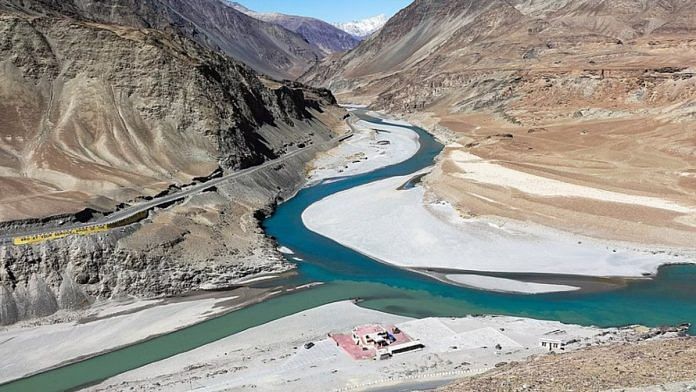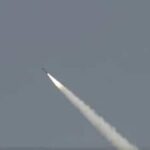Even if the words were hyperbole, they spoke to Lashkar’s rank and file, drawn from the landless peasantry of arid southern Punjab and the region’s lower-middle-class traders. “The Hindu is a mean enemy,” , “and the proper way to deal with him is the one adopted by our forefathers, who crushed them by force.”
That message was already losing its power after the Kargil war—even as Saeed delivered his speech—as Pakistan’s middle class saw that the India it had been taught to revile was becoming increasingly prosperous and cosmopolitan. A decision to withdraw from the Indus Waters Treaty, though, could reunite a nation behind its Generals and its jihadist proxies.
For almost ten years now, Prime Minister Narendra Modi’s government has considered withdrawing from the Indus Waters Treaty, seeing it as a leverage tool less dangerous than war. Following the Lashkar-e-Taiba’s attack on the 12 Brigade headquarters in Uri—which the by putting up posters for its slain jihadists in Gujranwala—the Prime Minister chaired a high-level meeting to consider whether cutting off Indus waters could serve as a reprisal. Modi spoke , echoing the same tropes as Hafiz Saeed: “Blood and water cannot flow together.”
Though the meeting led to a decision to speed up work on three ongoing hydroelectric projects on the Indus system, the practical problems of using water as a means of coercion were evident. As researcher and Tufts University professor Haasan Khan in an article in Dawn, India simply doesn’t have the infrastructure to hold back the billions of cubic metres of water that flow down these rivers as the snows melt from May to September.
From experience, though, Indian planners had learned they did have a tool at hand. In late August 2008, India was alleged to have cut the flow of water to Pakistan by 20,000 cubic feet per second to fill up the newly built Baglihar Dam’s reservoir, searing fields across Pakistani Punjab. Then-President Asif Ali Zardari, as declassified United States , angrily protested to Prime Minister Manmohan Singh, aware that water shortages had empowered his political enemies at home.
Anne Patterson, the US ambassador in Islamabad, noted in a : “As economic woes in Pakistan continue to intensify, domestic agricultural production becomes more essential for food security, and water will become a more highly sought commodity across the Line of Control.”
Meanwhile, on a barnstorming tour of his southern Punjab heartland, the Lashkar chief claimed fields across Punjab were turning to dust because of Indian “water terrorism”. Hindu India, , was building dams in Kashmir to choke Pakistan’s water supplies and cripple its agriculture. For Pakistan, he prophesied, a moment of decision lay ahead: The “crusaders of the East and West have united in a cohesive onslaught against Muslims”.
The carnage of 26/11—years in the planning, as we now know of Pakistani-American terrorist David Headley—was carried out just five weeks after that speech. A plausible hypothesis for the timing is that public anger over the water issue gave Lashkar the excuse it needed to conduct a massacre that could provoke war—and gave Army Chief General Pervez Kayani a reason to shut down the secret peace process his predecessor had initiated with India.
Likely because of this realisation, Prime Minister Modi did not deploy the water weapon again during the crises that marked his tenure—even though some analysts in New Delhi continued to push the idea. Instead, the Prime Minister turned to conventional force, authorising cross-Line of Control raids in 2016 and air strikes in 2019. Following the 2016 attacks, jihadist strikes outside Kashmir came to an end. After the 2019 air strikes, levels of violence in Kashmir diminished, leading to the renewal of the Pakistan-India ceasefire along the Line of Control.
There remains debate over whether the counter-attacks deterred Pakistan, or whether the threat of Western financial sanctions was, in fact, key—but either way, Prime Minister Modi’s objectives were met. After the abrogation of Article 370, the Pakistan Army kept its jihadist proxies in check, leading in violence. The peace held even after India withdrew troops from the Line of Control during the crisis with China.
Then came Pahalgam—and the same choices that have confronted every Prime Minister since 1947 reemerged. Was the use of kinetic military means necessary to deter Pakistan from using its jihadist proxies? If so, what were the chances of escalation into a full-scale war in which economic costs might outweigh the gains? And were there means other than war to pressure Pakistan?
Legally, India’s decision to place the Indus Waters Treaty in abeyance rests on uncertain ground—but at some stage, it will either have to roll back its decision or move forward toward abrogation. Field Marshal Ayub Khan and Prime Minister Jawaharlal Nehru clearly did not intend for either country ever to exit the Indus Waters Treaty unilaterally. There is no clause outlining circumstances under which either India or Pakistan it on their own. Instead, the treaty states only that its provisions may be modified or replaced by “a duly ratified treaty concluded for that purpose between the two Governments”.
The 1969 Vienna Convention on the Law of Treaties does outline circumstances in which treaties without an explicit provision. Article 56 lists just two such get-out-of-jail routes: if it “is established that the parties intended to admit the possibility of denunciation or withdrawal,” or if a “right of denunciation or withdrawal may be implied by the nature of the treaty.”
Since at least 1949, international law has held that repudiating treaties without an enabling clause requires the consent of the parties. Legal scholar Laurence Helfer puts it thus: the law is “rounded on a fundamental principle: pacta sunt servanda—treaties must be obeyed.”
Like other powers, of course, India could simply choose to ignore international law. The United States mined Cuban harbours and armed Nicaraguan insurgents. China recently rejected an international court’s verdict on the South China Sea, dismissing the rules of the International Convention on the Law of the Sea. Israel has ignored the laws of war in Gaza, Palestine without consequences.
Yet, world opinion does matter. In 1999, for instance, US pressure helped India during the Kargil conflict, and Financial Action Task Force (FATF) sanctions played a role in compelling Pakistan to rein in its jihadists.
For obvious reasons, international support would be harder to recruit if India were seen as deliberately inflicting drought on millions. Few countries—including India—would welcome massive refugee flows and the weakening of state authority in Pakistan. If the Pakistani state were seen as unable to defend its people from drought inflicted by a hostile neighbour, its legitimacy could erode, with dangerous consequences. Islamist groups could conceivably grow strong enough to rule swathes of southern Punjab.
Thus, India might end up facing more violence, not less—with the risk that violence carried out in retaliation for deliberately inflicted thirst, for obvious reasons, would carry far less moral opprobrium than violence driven by religion.
Frustration makes for bad policy. India needs ice-cold clarity on its next steps—not thinking coloured by the heat of rage.
Praveen Swami is contributing editor at ThePrint. His X handle is @praveenswami. Views are personal.
(Edited by Prashant)






